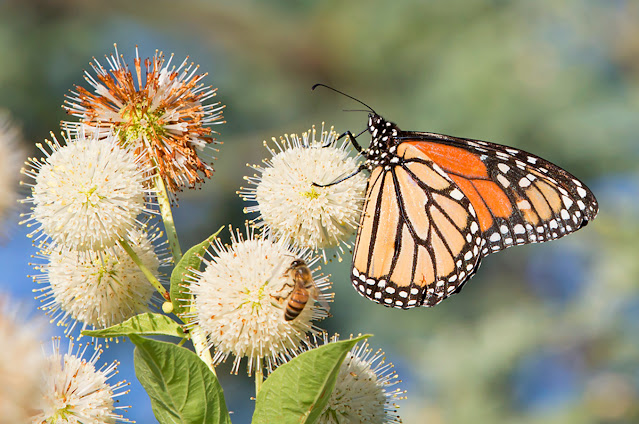Tucson Audubon’s Efforts to Protect the Now Endangered Monarch Butterfly
By Jonathan Horst
 |
| Photo by Ned Harris |
The monarch butterfly (Danaus plexippus) was listed by the International Union for the Conservation of Nature as endangered* on July 19 2022. Since the 1980s there’s been a 95% decline in the western monarch population—those that mostly overwinter in southern California. The eastern population, those that mostly overwinter in Mexico, has fared better but has still experienced a 70-80% reduction. (See a map showing both migration routes). In Tucson we get individuals from both populations migrating to their respective winter homes.
 |
| Arizona milkweed by Jonathan Horst |
Even though they’re not birds, Tucson Audubon has been working to protect monarch butterflies by improving their habitat here in Southeast Arizona for over 8 years. In addition to a good number of Monarch Waystations/pollinator gardens that we’ve installed in public areas, we also try to integrate pollinator plants and milkweeds, the host plant for monarch larvae, into all residential and community habitats that we create through our Habitat at Home program. We’ve recently added an a la carte certification for monarchs and are working on additional resources for homeowners. With experts from the Arizona-Sonora Desert Museum, we developed best practices for residential milkweed plantings. Three of our staff members contribute to the different committees of the Arizona Monarch Collaborative (Erin Zylstra on the Research Committee; Kim Matsushino on Outreach; Kari Hackney on Habitats) and we’ve worked on numerous proposals for landscape scale monarch conservation. Our Quantitative Ecologist, Dr. Zylstra, authored a paper projecting the effects of future climate on the eastern monarch population that was just published in the scientific journal Global Change Biology—research she led as part of her previous position as a post-doctoral researcher with Michigan State University.
The US Fish and Wildlife Service's Monarch Joint Venture has a map of conservation projects. Tucson Audubon is involved in most of the Arizona projects (see the table below). From the Ash Canyon Bird Sanctuary to Buenos Aires National Wildlife Refuge and many locations in between, we have planted over 500 milkweeds of various species and over 1800 other nectar-producing plants—the work is ongoing!
 |
| Monarch Waystation at the Tucson Audubon Paton Center for Hummingbirds, prepped for install. Each color of whiskers indicated a different species of milkweed being planted in the meadow. See a post about this project. |
Get involved in protecting monarch butterflies!
- Donate to Tucson Audubon to support our conservation work
- Contribute to the Milkweed Mapper to log your monarch or milkweed sightings
- Tucson Sentinel Article: What Arizonans Can do To Help Monarchs
- Check out our Monarch Habitat Guide for Homeowners
At Tucson Audubon, we’ll continue to invest in monarch conservation throughout the region. We have many more projects in the proposal stage and will continue to include monarch habitat in future projects.
Here’s to a better future for monarch butterflies!
* Though listed as “Endangered” by the IUCS, the monarch is not yet
federally listed by the US Fish and Wildlife Service, and therefore has
no regulatory protections. In December 2020, the USFWS determined its
listing under the Endangered Species Act was "warranted but precluded"
by higher priority species, so it was put on the candidate list and its
status should be reviewed annually.
Jonathan Horst is Tucson Audubon’s Director of Conservation and Research.



Comments
Post a Comment
Thanks, we value your opinions! Your comment will be reviewed before being published.